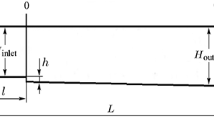Abstract
Experiments is presented on burning of hydrogen injected into a channel (duct) with a supersonic high‐temperature flow at the entrance are analyzed using a specially developed two‐dimensional semi‐empirical model based on numerical integration of parabolized Navier–Stokes equations with regard for finite rates of chemical reactions. It is shown that the appearance of two combustion modes with “short” and “long” regions of elevated pressure in the experiments considered is caused by the fact that heat release may occur both in an immediate vicinity of injectors and along the whole duct with the formation of a global separation (stagnation) region. The duct flow in both combustion modes remains supersonic, except for regions limited in size.
Similar content being viewed by others
REFERENCES
R. Walter, V. Sabelnikov, Y. Korontsvit, et al., "Progress in joint German-Russian scramjet technology programme," ISABE 95–7121 (1995).
R. Walter, W. Koschel, V. Sabelnikov, et al., "Investigations into the aerothermodynamic characteristics of scramjet components," ISABE 97–7085 (1997).
E. S. Shchetinkov, "Piecewise-one-dimensional models of supersonic combustion and pseudoshock in a duct," Fiz. Goreniya Vzryva, 9, No. 4, 473–483 (1973).
P. K. Tret'yakov, "Determination of heat input to a duct ow with a pseudoshock," Fiz. Goreniya Vzryva, 19, No. 3, 71–77 (1993).
P. K. Tret'yakov, "Pseudoshock combustion regime," Fiz. Goreniya Vzryva, 19, No. 6, 33–38 (1993).
O. M. Kolesnikov, "Effect of oscillations of concentrations on ignition of a near-wall hydrogen jet in a supersonic flow," Fiz. Goreniya Vzryva, 21, No. 1, 53–58 (1985).
O. M. Kolesnikov, "Numerical simulation of the pseudoshock caused by combustion of near-wall hydrogen jets in a planar duct," Izv. Ross. Akad. Nauk, Mekh. Zhidk. Gaza, No. 2, 196–200 (1997).
B. Juergens and W. Koschel, "Thermal analysis of fluid-structural interaction in high-speed engine flow fields," ISABE 99–7139 (1999).
O. M. Kolesnikov, "Calculation of two-dimensional interaction of a transverse burning hydrogen jet and a supersonic flow," Uch. Zap. TsAGI, 23, No. 2, 38–46 (1992).
M. Barnett and G. D. Power, "An effcient algorithm for strong viscous/inviscid interaction in hypersonic flows," AIAA Paper No. 88–712 (1988).
G. D. Power, "A novel approach for analyzing supersonic high Reynolds number ow with separation," AIAA Paper No. 90–0764 (1990).
S. A. Zosimov and O. M. Maleta, "Experimental study of hydrogen combustion in a variable-section duct with a supersonic velocity at the entrance," in: Modern Problems of Aerospace Science, Proc. Conf. of Young Scientists of Central Aerohydrodynamic Institute, Zhukovskii (1996), pp. 22–25.
Author information
Authors and Affiliations
Rights and permissions
About this article
Cite this article
Kolesnikov, O.M. Two‐Dimensional Semi‐Empirical Numerical Model for Analysis of Experimental Data on Supersonic Combustion of Hydrogen. Combustion, Explosion, and Shock Waves 37, 617–625 (2001). https://doi.org/10.1023/A:1012921227918
Issue Date:
DOI: https://doi.org/10.1023/A:1012921227918




